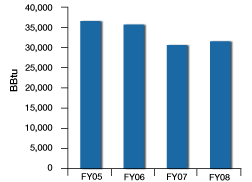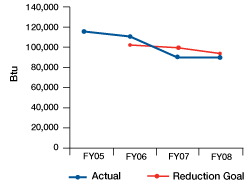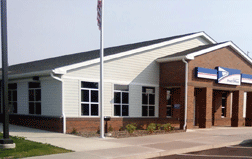Our Environment
Building Energy Use and Intensity
To improve energy efficiency in Postal Service facilities, we’ve implemented a nationwide strategy and are improving the availability and accuracy of facility performance data to enhance our decision making.
We have ambitious goals for our owned and leased facilities. By 2015, we plan to reduce both total energy use and energy intensity (measured in energy use per square foot) by 30 percent from a 2003 baseline.
Achieving both goals requires a combination of initiatives, including implementing energy management systems, conducting detailed facility energy audits, making cost-effective capital improvements to buildings and their equipment, and actively involving our employees in energy reduction and conservation.
Solid steps are being taken toward meeting our owned and leased facility goals. In 2008, the Postal Service consumed approximately 30.7 trillion Btu across our 34,000 facilities, which represents a 15 percent reduction in energy use since 2003.
We also have considerably reduced energy across our building footprint. In 2008, our average facility energy intensity was 94,400 Btu/ft2, a reduction of 17 percent from 2003
Looking toward 2015, we’re optimistic about meeting our 30 percent reduction goals for both total energy use and intensity. While automated mail processing equipment increases our energy use in buildings, it typically reduces the overall number of buildings used to process the 200 billion pieces of mail we deliver each year, resulting in an overall energy-use reduction.
Energy Management Data Systems
In early 2008, the Postal Service began implementing a Utility Management System (UMS). UMS was designed to facilitate central utility bill verification and payment and capture energy use and cost data of our largest facilities for our most common utilities — electricity, natural gas and steam.
Facility Energy Use

Facility Energy Intensity

We’re now rolling out the system on a broader scale, and by the end of 2009 it should include our largest 2,000 facilities, representing approximately 75 percent of energy use. UMS will provide facility-specific utility information at a level of accuracy previously unavailable to the Postal Service.
Also during 2008, we began developing an Enterprise Energy Management System (EEMS). It allows us to consolidate facility-related energy information into one location, measure and verify building equipment and system performance in real time, and monitor and control building systems locally and remotely. This helps us identify opportunities for improvement, reduce cost and consumption, increase efficiency and improve energy planning.
EEMS will expand through 2010 to include 28,000 facilities. EEMS lets us standardize results across differences in weather, location, facility size, mail volume or time period.
Energy Conservation
Our first priority for managing facility energy use is to identify and implement opportunities for savings. Facility energy audits help us evaluate our energy use and identify opportunities to manage it better.
In 2007, we began commissioning comprehensive energy audits at our most energy-intensive buildings. Through these audits, we identified potential energy reductions of up to 2 trillion BTUs and cost savings totaling $44 million by the end of 2008. As we conduct more audits, we will incorporate best practices and lessons learned from them into future reviews.
Many energy conservation opportunities identified to date are simple and repeatable, such as reprogramming thermostats, turning off lights and repairing compressed air leaks— often at little or no cost.
More complex improvements include upgrades and replacements of HVAC, lighting and compressed air systems— including controls which are crucial to realizing savings from the upgrades. In 2008, we encouraged implementation of energy efficient retrofits by modifying our building design criteria with stronger requirements for energy efficiency performance.

The Denver Post Office was one of the first LEED certified Post Offices in the country.
Green Buildings
USPS is committed to building and operating high performance, sustainable buildings. Our objective is to design and build all new construction and significant renovation projects to exceed the energy efficiency requirements of the leading building energy standard (ASHRAE 90.1-2004) by the greatest amount that is life-cycle cost effective.
To facilitate this, we require design teams to perform energy modeling on multiple alternative design concepts, and we select designs based on energy and financial considerations. We also require roofing materials to be Energy Star compliant to address the “heat island” effect.

Oregon’s Lebanon Post Office was built using eco-friendly materials and practices.
Our efforts go beyond just energy efficiency. Other sustainable attributes— low volatile organic compound (VOC) paints, recycled-content materials and low-flow plumbing fixtures are requirements for our designs. We also incorporate native plants in our landscaping to reduce irrigation requirements.
Our design criteria now include “green” lobbies that use a variety of environmentally friendly materials. And any new building construction we undertake meets the U.S. Green Building Council’s Leadership in Energy and Environmental Design (LEED) certification requirements.
Furthermore, the Postal Service has historically played a critical role in sustainable patterns of development in America through its locations for new Post Offices. Post Office locations are designed to be convenient to all customers by being centrally located.

Solar arrays like this one at the San Francisco Processing and Distribution Center are helping USPS use more sustainable forms of renewable energy
Renewable Energy
Another aspect of our sustainability strategy is to increase our use of renewable energy when it makes business sense. We’re exploring renewable technologies at several locations around the country.
Because postal facilities are located in a wide range of geographies and climates, a number of opportunities are available. For example, in the Pacific Area, the EPA honored USPS with an environmental achievement award for our solar photovoltaic, fuel cell and combined heat and power generation technologies.
We intend to make renewable energy a sustainable part of our operations, and we continue to evaluate projects that provide a favorable return on investment while creating additional environmental benefit. We’ve learned that energy conservation is often a better investment than site-specific renewable energy developments.
Nevertheless, we have 10 buildings with on-site solar photovoltaic systems, primarily in California, and we continue to pursue these and other economically and environmentally responsible systems.
Other Initiatives
The Postal Service has incorporated energy efficiency requirements into our mail processing equipment designs. The innovative Flats Sequencing System, a state-of-the-art sorting technology, was our first major purchase that considered these requirements.
Even in our offices, we are pursuing energy savings by replacing old computers and peripherals with energy-efficient models. The installation of power management software on our remaining hardware has conserved energy and cut operational costs.
During 2008, we replaced 104,000 computer workstations and bought 60,000 flat-panel monitors that use almost 70 percent less energy than their predecessors. In addition to the energy-saving benefits, this initiative is enabling USPS to achieve greater office productivity due to improved computer performance and virtual office features that reduce the need for expensive and energy-consuming travel.
Green From the Get-Go
Two recently constructed Oregon Post Offices feature the latest in green technology. The Lebanon and Sisters Post Offices were built using environmentally friendly building products and practices.
Extra insulation in the walls and roof maintain optimal interior temperatures. The paint is low in VOCs, and low-flow plumbing fixtures are in both Post Offices.
The lighting is high-efficiency fluorescent lamps. USPS also requires a waste management plan in its construction specifications ― meaning contractors are required to separate waste and recycle whenever possible.
Energy efficiency is the “greenest” thing about the buildings, according to Facility Requirements Specialist Linda McNulty.
She cites the facility’s high-efficiency HVAC systems ― that use less electricity than standard units. Rated at 96.6 percent efficient, the HVAC exceeds national standards by nearly 25 percent.
The eco-friendly touches don’t stop inside the building. There’s even something out front that fossil-fuel-conserving customers will find particularly useful ― a bike rack!
|
The Postal Service is testing the latest generation hydrogen fuel cell vehicles in Irvine, CA, and Washington, DC. A hydrogen fuel cell vehicle is more energy efficient than an internal combustion engine and emits only harmless water vapor. |
 |
|
|
|
